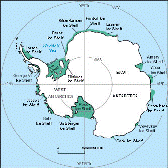Antarctic Drilling Program (ANDRILL)

ANDRILL Related Publications of Affiliates
Document Type
Article
Date of this Version
2007
Abstract
Latest Cretaceous to early Palaeogene climates in Antarctica are being investigated from an exceptional sedimentary sequence on Seymour Island (James Ross Basin, Antarctic Peninsula) to determine the nature of climate change at the end of the Cretaceous. It has been suggested that, following peak mid Cretaceous warmth, cooling during the Maastrichtian (~71-65 Ma) may have been severe enough for short-term glaciations at high latitudes, challenging the current view of an ice-free, Cretaceous greenhouse world. High resolution records of palaeontological, sedimentological, and geochemical signals are being obtained to investigate the climate and environmental context at the Antarctic margin prior to the Cretaceous/Tertiary extinctions, the biotic response in the marine and terrestrial realm, and to test the hypothesis of the presence of ice in conjunction with climate/ice sheet model simulations.


Comments
Citation: Thorn, V. C., J. E. Francis, J. B. Riding, R. W. Raiswell, D. Pirrie, A. M. Haywood, J. A. Crame, and J. M. Marshall (2007), Terminal Cretaceous climate change and biotic response in Antarctica – Online Proceedings of the 10th ISAES X, edited by A. K. Cooper and C. R. Raymond et al., USGS Open-File Report 2007-1047, Extended Abstract 096, 4 p.